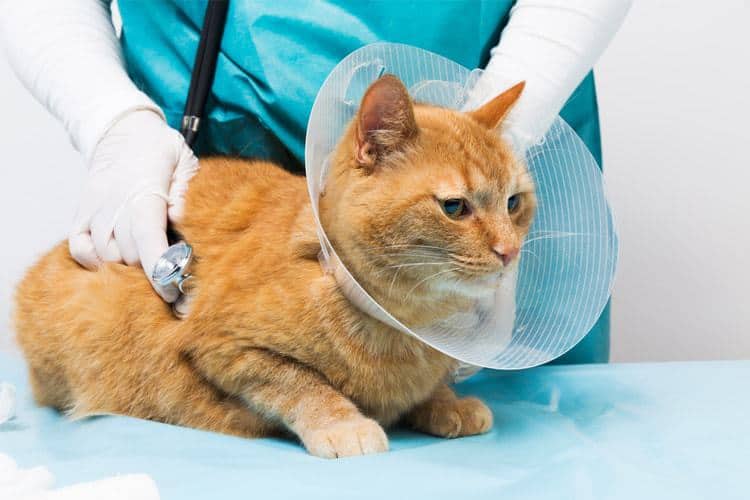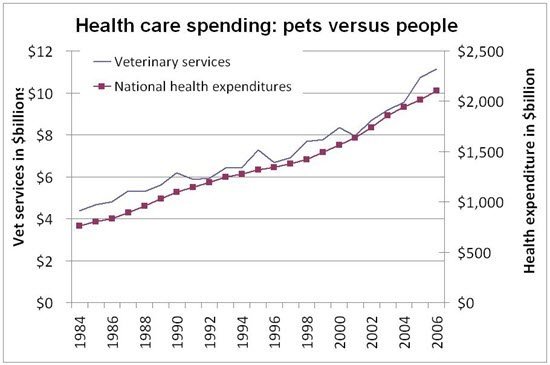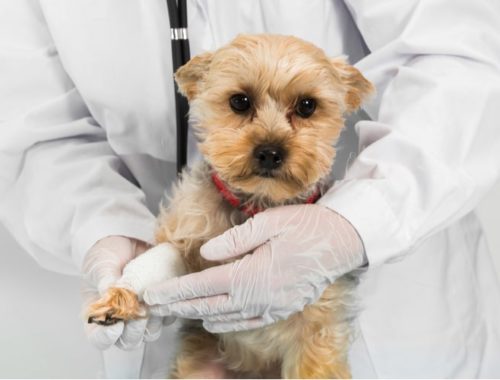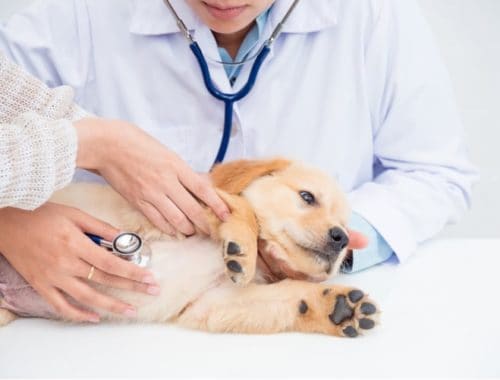Spending on pet healthcare in the U.S. continues to skyrocket. It is estimated that the total American pet industry expenditure will reach $69.36 billion, up from $66.75 billion in 2016. Supplies, over-the-counter medicine, and vet care accounted for just over $30 billion of the 2016 figure.

However, the rise in pet ownership does not tell the whole story. Costs are spiraling and the ASPCA estimates that the annual cost of owning a dog averages as much as $1,843.
In this guide, we will delve into why pet healthcare costs are so high and breakdown where the spending is going. We will also look at the types of pets that cost owners the most in healthcare and those that cost the least. In doing so, we will identify common ailments associated with different breeds, the associated treatments, and what they cost on average.
We have included the following sections in our guide:
- Pet Healthcare Overview
- Pet Healthcare Spending Breakdown
- Pets with Most and Least Health Problems
- Most Common Pet Ailments (with Infographic)
- Pet Healthcare Financial Options
- How to Keep Your Pet Healthy
- Pet Health Resources
Read on to learn all about the state of pet healthcare this year.
Pet Healthcare Overview

While it is unlikely that your dog will take your mother’s seat at the dinner table anytime soon, it is true that pets are now seen as part of the family which might go some way to explaining the increased spending. Research shows that 95% of Americans consider their pet to be a member of the family, up from 88% in 2007. To further this notion of the pet as a family member, 45% of pet owners admit to buying birthday presents for their pets with 31% saying they cook for their pet. It is no coincidence pet healthcare costs are increasing at a time when pets are increasingly been seen as part of the family. Owners, it seems, are more willing than ever to pay whatever it costs to keep their beloved pets in good health, even spending more on their pet’s health than they do on their own.
Changing perceptions about the role of the pet within the family might explain the increase in pet health spending to some extent but it does not tell the whole story. It is also true that veterinary technology has advanced considerably. These changes in veterinary technology mean that complicated medical procedures have become available to pet owners willing to pay for them. Vets refer to the maximum amount pet owners will pay on veterinary procedures as the “stop treatment point” and, unsurprisingly, this amount has been increasing steadily.
The transition of the pet to an almost fully-fledged family member coupled with the availability of more advanced, expensive veterinary procedures has led us into a situation where a three-year-old female French Bulldog with an intervertebral disc disease racked up a medical bill of $44,296.
The cost of pet healthcare shows no signs of slowing down, but it is not all bad. Research shows that there are a number of health benefits to owning a pet including heart disease prevention, stress reduction, and lowering blood pressure. Increased spending on your pet’s health might just keep your own healthcare costs down.
Pet Healthcare Spending Breakdown

- Surgical vet visits which cost owners a yearly average of $474 for dogs, $245 for cats, and $45 for birds.
- Sick vet visits cost owners a yearly sum of $204 for dogs, $244 for cats, and $138 for birds.
- Emergency vet visits cost owners a yearly average of $349 for dogs, $154 for cats, $107 for birds, and $471 for horses.
- Heartworm medication cost dog owners an average $102 per year, while cat owners paid out $65 per year. Horse owners paid an average of $540 per year on hoofcare.
- Routine vet visits which cost owners a yearly average of $257 for dogs, $182 for cats, $102 for birds, and $549 for horses.
- Vitamins and supplements which cost a yearly average of $58 for dogs, $46 for cats, $43 for freshwater fish, $132 for saltwater fish, and $40 for birds.
- Medicated tick and flea control products cost dog owners an average of $85 per year while cat owners paid $77 per year. Bird owners paid $49 per year on medicated shampoo and horse owners paid $102 on insect control products.

Some other interesting findings in the APPA Pet Owners Survey on pet health spending include:
- The average number of visits to the vet per year is 2.7 for dog owners, 2.2 for cat owners, and 3.1 for bird owners.
- The most popular services received at the vet’s office include routine physicals – performed on 48% of dogs and 31% of cats – and vaccines.
- 21% of dog owners and 18% of cat owners now use calming products.
- In spite of rising healthcare costs, less than 1% of owners have pet health insurance.
An interesting side note to the ever-increasing pet health expenditure is that it has risen at an even faster rate than human healthcare. A study carried out by economists Liran Einav, Amy Finklestein, and Atul Gupta found that pet healthcare spending increased by 60% between 1996 and 2012 while human healthcare spending increased by 50% over the same period.

The fact that pet healthcare spending outgrew human healthcare is particularly interesting when you consider how few people invest in pet health insurance and how little regulation exists – two factors that are regularly cited as reasons behind America’s enormous healthcare spending.
Pets with the Most and Least Health Problems

Purebred dogs are the most in demand but can be plagued with genetic health issues. With over 4,000 years of breeding with specific physical features in mind, the health of the pure breed has suffered. At the heart of this issue is popular sire syndrome where a champion male show dog will be bred widely with his genes spreading like wildfire regardless of whether they are healthy or not. Controlled breeding has certainly exacerbated pet health issues but, at the same time, breed standards such as those introduced by the American Kennel Club provide owners with important information on their dog’s temperament, appearance, and original purpose of the breed. One of the best ways new owners can avoid the heartache that goes with a sick pet is by asking breeders for medical tests and disease history in the pup’s family, questions they are perfectly entitled to ask.
Based on our research at Pango Pets, we have identified and ranked the breeds of dogs that have the most health issues. The top 10 is
- #10 Miniature Poodle: This breed has an average life expectancy of 14 years but is prone to eye issues like cataracts. Other concerns include epilepsy and progressive retinal atrophy (PRA).
- #9 Newfoundland: The Newfoundland has a life expectancy of 9 years and is prone to canine hip dysplasia (CHD) and subvalvular aortic stenosis which can result in sudden death.
- #8 Rottweiler: The Rottweiler is also prone to CHD. They also suffer from Osteosarcoma which is a degenerative disease of the bones.
- #7 Labrador Retriever: This popular breed also suffers from CHD. Other concerns include cancer, gastric torsion, and muscular dystrophy.
- #6 Basset Hound: The Basset Hound has a life expectancy of ten years but suffers from a number of genetic diseases including canine thrombopathia (CTP), ectropion, glaucoma, otitis externa, and Von Willebrand Disease (vWD) which can result in excessive bleeding from even a minor cut.
- #5 Saint Bernard: The Saint Bernard has an average life expectancy of nine years and suffers with a number of ailments including bone cancer, CHD, elbow dysplasia, and entropion.
- #4 Golden Retriever: One of the most popular breeds of dogs, Golden Retrievers usually live for 12 years but are prone to cataracts as well as hip and elbow dysplasia.
- #3 Bulldog: Bulldogs are renowned for their health issues including locomotion issues, breathing problems, and the inability to mate or give birth without assistance. They have been labeled “the most extreme example of genetic manipulation in the dog-breeding world that results in congenital and hereditary problems” by Wayne Pacelle, the CEO and President of the Humane Society of the United States.
- #2 German Shepherd: Unfortunately German Shepherds have become known for their hip dysplasia problems. They also suffer with elbow dysplasia and other ailments like vWD, Pannus, and Gastric Torsion.
- #1 Cocker Spaniel: Ranked number one on the list of unhealthy dog breeds, Cocker Spaniels have a range of health concerns including albinism, cataracts, epilepsy, heart disease, and liver disease.

If you are worried about the costs – both financial and emotional – that come with caring for a sick pet, there are healthier dog breeds out there to consider as pets. While there is no guarantee that any pet will live a healthy, disease-free existence, you should, at the very least, make yourself aware of the breeds least likely to suffer genetic health problems.
The dog breeds with the fewest health problems include the:
- Australian Cattle Dog: The Australian Cattle Dog has a history of living a healthy life. There are however three issues which occasionally pop up which you will have to look out for namely progressive retinal atrophy, hip dysplasia, and deafness.
- Border Collie: Also known for their good health. Genetic conditions to watch out for here are collie eye anomaly, epilepsy, and hip dysplasia. These issues arise in the minority of cases.
- Siberian Husky: A breed that is known for their good health. May encounter common ailments like cataracts, hip dysplasia, and other eye issues.
- Beagle: As with the other breeds on this list, Beagles may occasionally suffer from eye conditions, epilepsy, and hip dysplasia. These genetic issues can be tested for however, so obtaining a beagle from a reputable breeder can help you avoid these health problems. Beagles can become obese if owners do not keep track of their daily food intake. They are known as something of a greedy dog that will gorge on food if the situation allows them to.
- Mixed Breed Dogs: The debate around whether mixed breed dogs are healthier than purebreds has rumbled on for quite a while now. Some feel that the there has been too much focus on purebred dog’s physical features at the expense of their health. Research into this question is difficult because it is impossible to collect the perfect data set. A 2013 study by researchers at the University of California, Davis used medical records for over 27,000 dogs to look further into this issue. They compared the incidence of 24 genetic disorders in mixed versus purebred dogs and found that 10 were significantly more common in purebreds, 13 were no different, and only 1 was higher in mixed breed dogs.
If cats are your thing, then there are a number of breeds known for good health including Egyptian Maus, Bombays, Havana Browns, Ragamuffins, Korats, Turkish Vans, Russian Blues, British Shorthairs, Singapuras, and American Shorthairs. On the flip side, there are a number of breeds that visit the vet more frequently. They include Persian, Siamese, Abyssinian, Himalayan, Exotic Shorthair, Sphynx, and Scottish Fold.
Most Common Pet Ailments (and Infographic)

Skin Allergies: The most common health issue affecting dogs are skin allergies. The main symptom is scratching that results in hair loss and soreness. Some dogs might chew their feet or even rub themselves off the carpet. Vets recommend allergy testing and often will prescribe medication that suppresses a seasonal allergy like pollen. A skin test is most common here and usually costs around $200. Blood tests are another option and they cost $200-$300. You may also encounter an exam fee which can range from $50 to $200. Another thing to bear in mind here is your dog will need to be sedated before any skin allergy test and that may cost an extra $45-$100, although some vets would include sedation costs in the test fee. The final cost here is the post-allergy test treatment the vet prescribes for your dog and they can range from $600 to $1,100.
Ear Infections: Most dogs encounter ear infections at some point in their lives. If your dog is scratching its ear constantly they might well have an ear infection. There are three types of infection: ear mites, bacterial infection, and yeast infection. Ear mites can be treated with over the counter medicine which is available for around $13. Bacterial infections need to be treated with an antibiotic which can cost $10-$30, and yeast infections require antifungal medication which can cost from $2-$40.
Non-cancerous Skin Mass: Benign tumors in dogs are extremely common and are best left untreated unless they grow large in size. You should, however, take your dog to the vet any time you find a growth to make sure it is indeed benign.
Skin Infections: Skin infections are very common and can be bacterial or yeast related. The good news is that they are easy to treat. Skin infections can be treated by bathing your dog with a medicated shampoo usually available for less than $20.
Arthritis: Dog arthritis often affects dogs alongside common ailments like hip dysplasia, and knee ligament injuries. Symptoms include a reluctance to move, stiffness, and swollen joints. The best treatment for arthritis is a multi-pronged approach involving joint supplements, anti-inflammatories, physical aids, and a weight management program.
The top 5 most common ailments affecting cats are:
Bladder or Urinary Tract Disease: The most obvious symptom here is if your cat is urinating an excessive amount of times each day because little or no urine is being passed each time. Sometimes they will urinate blood. Treatment begins with a urine analysis. An x-ray or an ultrasound may also have to be carried out. You might need a course of antibiotics to solve the issue and many cats are put on strict diets.
Dental Disease: Dental disease in cats is usually caused by one of periodontal disease, oral cancer, feline stomatitis, or tooth resorption. The main symptom is usually inflammation of one tooth. Early stage treatment involves controlling plaque while later stage treatment requires antibiotic gel which costs around $15.
Chronic Kidney Disease: Kidney disease is widespread in cats and can be fatal. Symptoms include increased drinking, more frequent urination, vomiting, and weight loss. Unfortunately, chronic kidney failure in cats cannot be cured. Putting your cat on a strict diet can, however, prolong their life.
Vomiting: The best way to treat a vomiting cat is to withhold food and water until the vomiting has subsided.
Excessive Thyroid Hormone: Hyperthyroidism affects older cats who experience an increase in the production of thyroid hormones. Symptoms include weight loss, increased appetite, vomiting, and diarrhea. Treatment options include medication, surgery, and radioactive-iodine therapy. Transdermal antithyroid medications may need to be used for the rest of the cat’s life and cost an average of $700 per year.
10 Most Common Health Problems for Dogs and Cats (Infographic)
Here’s a handy, downloadable infographic that lists the most common pet health issues. It illustrates the 5 most common health problems for dogs and the top 5 for cats as well, along with key symptoms to watch for, treatment options and what it might cost.
If you add this infographic to your website, we ask that you credit Pango Pets as the source.
Pet Healthcare Financial Options

- Redrover Relief: This charity provides financial aid to pet owners with animals in need of urgent veterinary care.
- The Pet Fund: This nonprofit association helps out owners who face putting their pet down because they can’t afford the required medical treatment.
- CareCredit: CareCredit offers veterinary financing that makes it easier for owners to give their pets the healthcare they need.
There are also a number of dog-breed specific veterinary care assistance programs available including CorgiAid, Special Needs Dobermans, Labrador Harbor, LabMed, and Labrador Lifeline.
One way you can avoid the financial difficulties that sometimes arise with a sick pet is to take out pet health insurance. It is an industry that has been growing steadily since 2007 and some of the best pet insurance options include Embrace, Healthy Paws, Petfirst, Pets Best, Trupanion, and Pet Assure, which is a popular pet insurance alternative. There are even plans offered specifically to insure cats. And finally, yes…pet insurance can be expense. But there are cheaper options available if money’s tight.
How to Keep Your Pet Healthy

- Keep Your Pets Clean: Minimize the chances of bacteria-related illnesses by keeping on top of your pet’s hygiene. PetCoach have put together a really helpful guide on how to bathe your dog without the stress.
- Keep Your Pets Hydrated: Fresh water is absolutely vital to the health of your pet. It is important that they consume enough water on a daily basis. This helpful guide from Carol Bryant explains how you can get your dog to drink more water.
- Mentally Stimulate Your Pets: One of the best ways to stave off behavioral issues is to keep your pet’s mind busy. Jen Gabbard over at Puppy Leaks has put together a great guide on 10 Easy Ways to Give Your Dog More Mental Stimulation
- Keep Your Pet Away from Poisonous Plants: This tip might seem obvious but a lot of pet owners will be unaware of the types of plants they need to avoid. Luckily, Dr. Justine Lee has pinpointed the outdoor and indoor plants to keep your dogs and cats well away from.
- Give Your Pets the Right Food: While this tip might seem really obvious, the question to ask yourself is how do you know the food you are giving your pet is the right food. For dog owners, one great way to stay on top of the various dog food options is to check out our expert pet food reviews where we post regular and in-depth dog food reviews. Amazon’s Wag line of pet food products earned a high 4.3-star rating from our resident veterinarian. None of the Wag recipes use added grain, corn, and wheat or artificial colors, flavors, or chemical preservatives. Another great, healthy option is to use a fresh dog food delivery service. These services deliver the freshest dog food made from the finest-quality ingredients straight to your door, so you there’s zero meal prep. Lastly, puppies require additional nutrition, so ensure you are feeding them a quality puppy food or organic dog food.
Useful Pet Health Resources
The following resources can help you stay on top of the latest developments in pet healthcare.
Pet Insurance Evaluation: The Canine Journal have put together a great pet insurance comparison post (https://www.caninejournal.com/pet-insurance-comparison) where they review the various options.
Pet Nutrition: The Tufts Veterinary Medical Center Pet Foodology Blog is a really valuable resource for expertise on a range of issues like pet nutrition, dog care, and impulse control.
Pet Welfare: The American Veterinary Medical Association (AVMA) is a not-for-profit association representing more than 89,000 vets. Their website contains a knowledge base which contains some great information on pet welfare among other topics.

Human-Animal Interaction: Dr. Marty Becker (pictured) wrote the book on pet ownership – 25 times to be exact. He regularly updates his blog with insights gained from an impressive career in veterinary. His blog is a great resource that covers topics like pet owner relationships and rescues.
AAHA – The League of Champions: Is your animal hospital or veterinarian AAHA Accredited? Find out why AAHA Accreditation is such a big deal and why your pet deserves gold standard care and treatment. Read more here.
Top Pet Product Reviews:
- The Best Invisible Dog Fence
- The Best Pet GPS Tracker
- The Best Beds for Large Dogs
- The Best Automatic Pet Feeder
- The Best Canine Probiotic
- The Best Dog Grooming Clippers
- The Best Pet Gate
- The Best Dog Camera
- The Best Dog Crates
- The Best Dog Stroller
Featured Image Credit: bmf-foto.de, Shutterstock
























